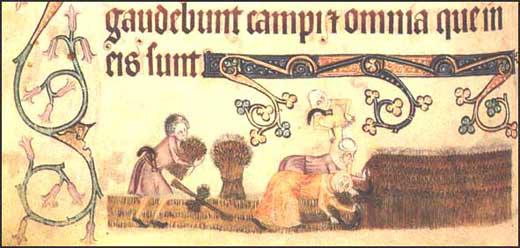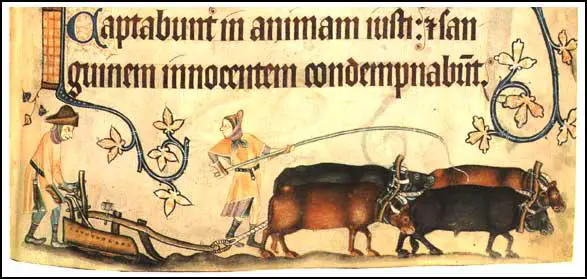Harvesting
In Yalding, like other villages in England, the hay is cut in June and July. It is very important to cut hay when it is hot and dry. If the hay becomes wet, the people have to spend valuable time turning it until it is dry.
The crops are usually harvested in July and August. Weather is an important factor in deciding when harvesting should begin. Heavy rain just before harvest, ruins the crop. Yields are also low if there is too much sun and not enough rain.
Wheat is cut half way up the stalk by the reapers using sickles. The field workers usually work in teams of five. A team consists of four reapers followed by a binder, who gathers the spears of cut wheat into sheaves. It normally takes a day for five people to harvest two acres. Oats and barley are mown with a scythe close to the ground. The stalks are then gleaned. This involves gathering up ears of corn left by the reapers. This work is usually done by children and old people.

Sometimes it is necessary to employ labourers to help during harvest time. This labour is usually provided by those people who do not produce enough food from their land to feed their families. These labourers are normally paid in sheaves. A day's pay was one sheaf of wheat or two of barley. Sometimes the labourers ask to be paid in money. In 1336 the pay is one penny a day.
After the crops have been harvested, the grain has to be ground down to produce flour. Some people use simple devices such as querns and hand-nulls to do this. Others use Hugh de Audley's water-mill.

When the harvesting has been completed, the villagers are allowed to turn their animals into the fields. The sheep are always the last to be allowed in. As the sheep crops the stems so close to the ground, they leave very little food for the rest of the animals. The droppings of the grazing animals provide the manure needed to improve the quality of the land.
The land then has to be prepared for next season's harvest. First the land is ploughed. The plough is an instrument with mouldboard and coulter, drawn by four, six or eight animals. The number of animals used depends on the kind of soil and its condition at ploughing time. The first ploughing turns what was left of the crop, weeds and grasses. The second ploughing, less deep than the first, prepares the ground for seeding. The timing of the ploughing and seeding is very important. In the spring the soil has to be fairly warm and in the autumn, it has to be done before the arrival of the frost.
